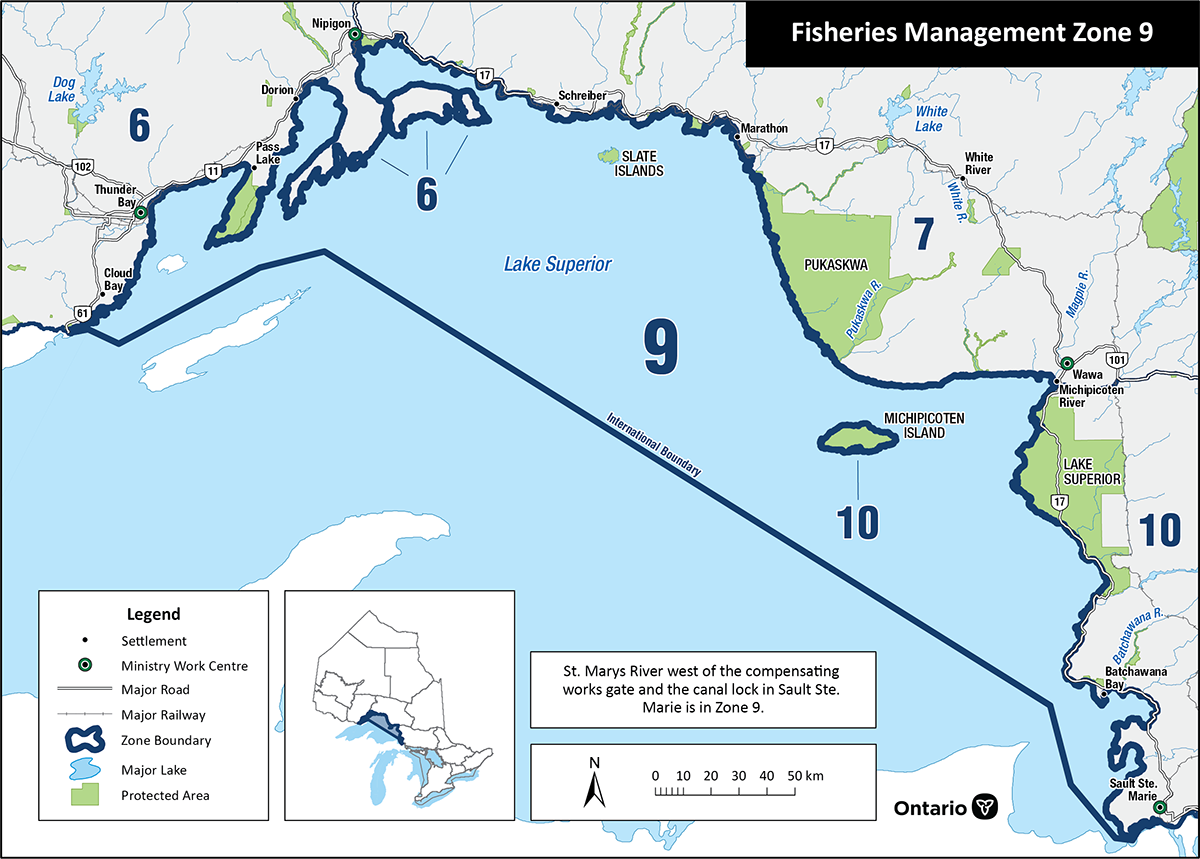Fisheries Management Zone 9 (FMZ 9)
Information about fishing and how fish resources are managed in Fisheries Management Zone 9 (Lake Superior).
News and updates
Fisheries management planning is not currently underway for this zone.
Fishing rules
You can:
- find specific rules for fishing in FMZ 9
- use the Fish on-Line mapping tool
- find a complete set of fishing rules in the Ontario Fishing Regulations Summary
About this zone
FMZ 9 includes the Canadian waters of Lake Superior. This zone has:
- the largest surface area of any freshwater lake in the world
- some of Lake Superior’s most unique aquatic and terrestrial environments
- provincially and nationally protected features, including the proposed Lake Superior National Marine Conservation Area
- important Indigenous, recreational, commercial and tourism-based fisheries
- prominent fisheries for native lake whitefish, (coaster) brook trout, lake trout, walleye and yellow perch, as well as introduced species such as Chinook salmon, coho salmon and rainbow trout in both the open waters and tributaries
- an active commercial fishery that currently targets cisco, lake whitefish, and lake trout
FMZ 9 is one of 20 fisheries management zones in the province.
Location
FMZ 9:
- its northwestern boundary is the international border at the Pigeon River
- bordered to the southeast by the compensating works on the St. Mary’s River in Sault Ste. Marie
- its southern boundary is the Canada – US border dividing Lake Superior
- includes the Lake Superior islands other than St. Ignace and Simpson Islands (FMZ 6) and Michipicoten Island (FMZ 10)
- boundaries extend, in most cases, across river mouths of Lake Superior tributaries
- cities include Thunder Bay and Sault Ste. Marie, as well as the towns of Dorion, Red Rock, Nipigon, Rossport, Schreiber, Terrace Bay, Marathon and Wawa
Legal boundary map and detail maps
Legal boundary map for FMZ 9 and detail maps 1 - 25 (PDF)
Monitoring reports and management plans
- Joint strategic plan for management of Great Lakes fisheries
- Fish community objectives for Lake Superior
- A stocking plan for the Ontario waters of Lake Superior
Zone advisory council
The FMZ 9 council provides advice during the development of fisheries objectives and strategies.
Council members represent a broad range of views including:
- Indigenous interests
- angling and commercial fishing groups
- scientists and researchers
- conservation groups
- interested community members
The advisory council participates in fisheries management by:
- sharing ideas and expertise with the ministry
- helping to develop and implement management strategies
- communicating with the local angling communities
For more information about the Fisheries Management Zone 9 advisory council, please contact the Upper Great Lakes management unit at
Walleye population monitoring and rehabilitation in Black Bay
Black Bay is a large bay on the north shore of Lake Superior.
Before the 1960s, Black Bay was the site of the lake’s largest commercial walleye fishery. Intense commercial and recreational harvest of walleye, and loss of access to the upper Black Sturgeon River’s spawning habitat, may have played a role in the:
- collapse of the walleye population in the bay
- failure of the walleye population to fully recover
Since 2016, we have been researching walleye spawning locations and movements within Black Bay and into Lake Superior to confirm where walleye are spawning in Black Bay and in the river below the dam. Ongoing research results show signs that walleye are recovering from historically low numbers, and we will continue to track the population’s recovery. This research will help us determine how to protect and recover the walleye population.
The current level of sea lamprey control provided by the Camp 43 Dam continues, after the repairs were completed in late 2020. This aligns with our commitment to control the spread of invasive aquatic species in Ontario.
